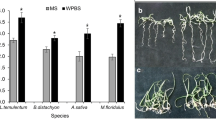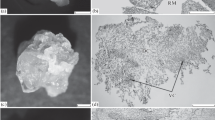Abstract
Friable, embryogenic maize (Zea mays L.), inbred line A188, callus was established and maintained for more than one year without apparent loss of friability or embryogenic potential. Embryoid development was abundant in these cultures and plants were easily regenerated. Frequencies of friable-callus initiation and somatic-embryoid formation increased linearly with addition to N6 medium (C.C. Chu et al. 1975, Sci. Sin. [Peking] 18, 659–668) of up to 25 mM L-proline. Proline additions up to 9 mM to MS medium (inorganic elements of T. Murashige and F. Skoog 1962, Physiol. Plant. 15, 473–497, plus 0.5 mg 1-1 thiamine hydrochloride and 150 mg 1-1 L-asparagine monohydrate) did not stimulate embryoid formation. A major part of the difference between MS and N6 media could be attributed to their respective inorganic nitrogen components. L-Glutamine was not a satisfactory substitute for L-proline. Of 111 regenerated plants grown to maturity from three independent friable, embryogenic cell lines ranging in age from three to seven months, only four plants were abnormal based on morphology and pollen sterility. Seed was produced by 77% of the regenerated plants.
Similar content being viewed by others
Abbreviations
- 2,4-D:
-
2,4-dichlorophenoxyacetic acid
- MS:
-
medium containing inorganic elements of Murashige and Skoog (1962), plus 0.5 ml 1-1 thiamine hydrochloride and 150 mg 1-1 L-asparagine monohydrate
- N6:
-
medium of Chu et al. (1975)
References
Armstrong, C.L. (1984) Genetic and environmental factors affecting the initiation of friable maize callus capable of somatic embryogenesis. M.S. thesis. University of Minnesota, St. Paul
Armstrong, C.L., Green, C.E. (1982) Initiation of friable, embryogenic maize callus: the role of L-proline. Agron. Abstr. 74, 89
Britikov, E.A., Schrauwen, J., Linskens, H.F. (1970) Proline as a source of nitrogen in plant metabolism. Acta Bot. Neerl. 19, 515–520
Chourey, P.S., Zurawski, D.B. (1981) Callus formation from protoplasts of a maize cell culture. Theor. Appl. Genet. 59, 341–344
Chu, C.C., Wang, C.C., Sun, C.S., Hsu, C., Yin, K.C., Chu, C.Y., Bi, F.Y. (1975) Establishment of an efficient medium for anther culture of rice through comparative experiments on the nitrogen sources. Sci. Sin. (Peking) 18, 659–668
Dunstan, D.I., Short, K.C., Thomas, E. (1978) The anatomy of secondary morphogenesis in cultured scutellum tissues of Sorghum bicolor. Protoplasma 97, 251–260
Green, C.E. (1977) Prospects for crop improvement in the field of cell culture. Hort Science 12, 131–134
Green, C.E. (1982) Somatic embryogenesis and plant regeneration from the friable callus of Zea mays. In: Plant tissue culture 1982, pp. 107–108, Fujiwara, A., ed. Maruzen, Tokyo
Green, C.E. (1983) New developments in plant tissue culture and plant regeneration. In: Basic biology of new developments in biotechnology, pp. 195–209, Hollaender, A., Laskin, A.I., Rogers, P., eds. Plenum Press, New York
Green, C.E., Phillips, R.L. (1975) Plant regeneration from tissue cultures of maize. Crop Sci. 15, 417–420
Green, C.E., Armstrong, C.L., Anderson, P.C. (1983) Somatic cell genetic systems in corn. In: Advances in gene technology: molecular genetics of plants and animals, pp. 147–157, Downey, K., Voellmy, R.W., Ahmad, F., Schultz, J., eds. Academic Press, New York London
Hibberd, K.A., Green, C.E. (1982) Inheritance and expression of lysine plus threonine resistance selected in maize tissue culture. Proc. Natl Acad. Sci. USA 79, 559–563
Jefferies, R.L. (1980) The role of organic solutes in osmoregulation in halophytic higher plants. In: Genetic engineering for osmoregulation: impact on plant productivity for food, chemicals, and energy, pp. 135–154, Rains, D.W., Valentine, R.C., Hollaender, A., eds. Plenum Press, New York
Le Rudulier, D., Strom, A.R., Dandekar, A.M., Smith, L.T., Valentine, R.C. (1984) Molecular biology of osmoregulation. Science 224, 1064–1068
Lu, C., Vasil, I.K., Ozias-Akins, P. (1982) Somatic embryogenesis in Zea mays L. Theor. Appl. Genet. 62, 109–112
Lu, C., Vasil, V., Vasil, I.K. (1983) Improved efficiency of somatic embryogenesis and plant regeneration in tissue cultures of maize (Zea mays L.). Theor. Appl. Genet. 66, 285–289
Murashige, T., Skoog, F. (1962) A revised medium for rapid growth and bioassays with tobacco tissue cultures. Physiol. Plant. 15, 473–497
Nabors, M.W., Heyser, J.W., Dykes, T.A., DeMott, K.J. (1983) Long-duration, high-frequency plant regeneration from cereal tissue cultures. Planta 157, 385–391
Price, H.J., Smith, R.H. (1979) Somatic embryogenesis in suspension cultures of Gossypium klotzschianum Anderss. Planta 145, 305–307
Schobert, B. (1977) Is there an osmotic regulatory mechanism in algae and higher plants? J. Theor. Biol. 68, 17–26
Siriwardana, S., Nabors, M.W. (1983) Tryptophan enhancement of somatic embryogenesis in rice. Plant Physiol. 73, 142–146
Sozinov, A., Lukjanjuk, S., Ignatova, S. (1981) Anther cultivation and induction of haploid plants in triticale. Z. Pflanzenzücht. 86, 272–285
Steel, R.G.D., Torrie, J.H. (1980) Principles and procedures of statistics: a biometrical approach. McGraw-Hill, New York
Stewart, C.R., Morris, C.J., Thompson, J.F. (1966) Changes in amino acid content of excised leaves during incubation. II. Role of sugar in the accumulation of proline in wilted leaves. Plant Physiol. 41, 1585–1590
Stuart, D.A., Strickland, S.G. (1984a) Somatic embryogenesis from cell cultures of Medicago sativa L. I. The role of amino acid additions to the regeneration medium. Plant Sci. Lett. 34, 165–174
Stuart, D.A., Strickland, S.G. (1984b) Somatic embryogenesis from cell cultures of Medicago sativa L. II. The interaction of amino acids with ammonium. Plant Sci. Lett. 34, 175–181
Vasil, V., Vasil, I.K. (1981) Somatic embryogenesis and plant regeneration from tissue cultures of Pennisetum americanum and P. americanum X P. purpureum hybrid. Am. J. Bot. 68, 864–872
Vasil, V., Wang, D., Vasil, I.K. (1983) Plant regeneration from protoplasts of Napier grass (Pennisetum purpureum Schum.). Z. Pflanzenphysiol. 111, 233–239
Wernicke, W., Brettell, R., Wakizuka, T., Potrykus, I. (1981) Adventitious embryoid and root formation from rice leaves. Z. Pflanzenphysiol. 103, 361–365
Author information
Authors and Affiliations
Additional information
Paper No. 13,904, Scientific Journal Series Minnesota Agricultural Experiment Station
Rights and permissions
About this article
Cite this article
Armstrong, C.L., Green, C.E. Establishment and maintenance of friable, embryogenic maize callus and the involvement of L-proline. Planta 164, 207–214 (1985). https://doi.org/10.1007/BF00396083
Received:
Accepted:
Issue Date:
DOI: https://doi.org/10.1007/BF00396083




